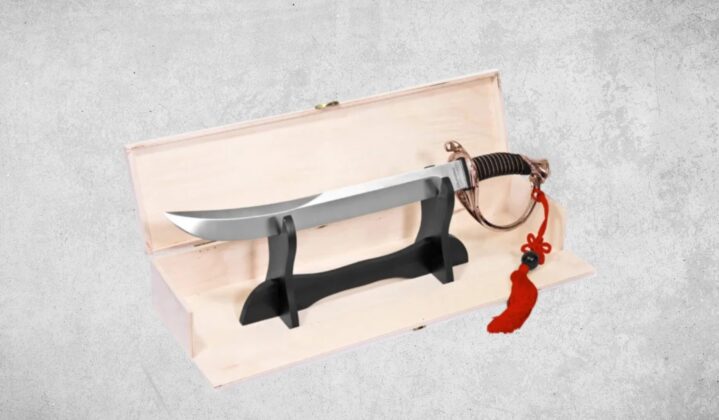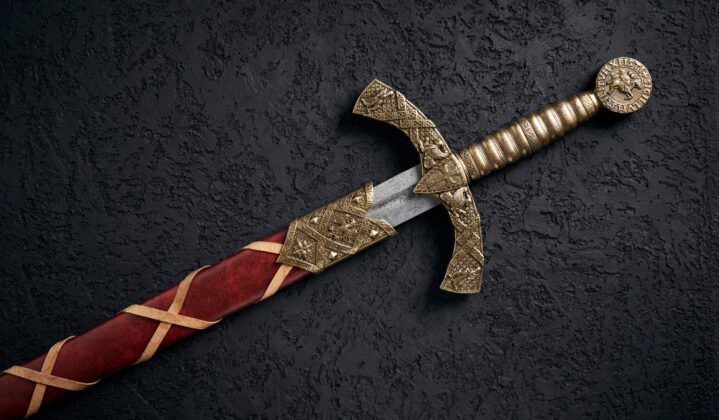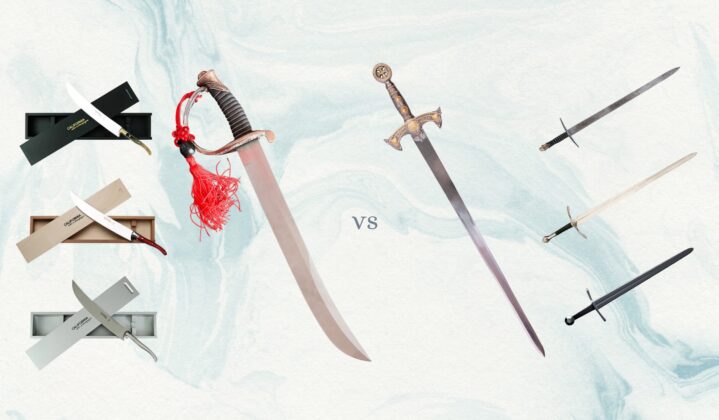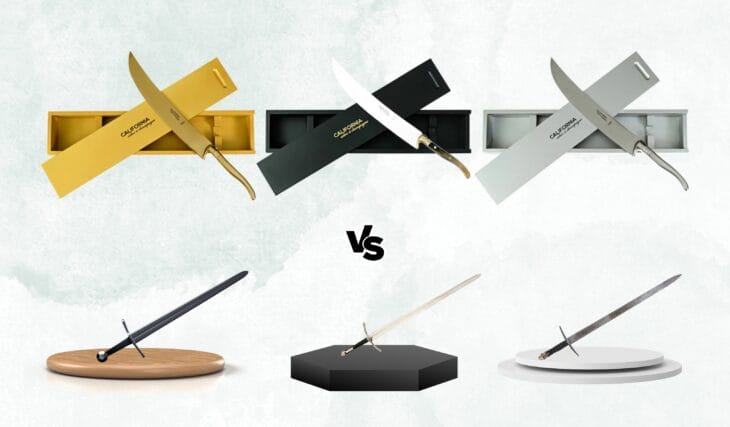Saber vs. Sword: Understanding the Difference and Their Role in Champagne Celebrations
Throughout history, blades have been more than mere tools or weapons; they’ve been symbols of power, honor, and cultural identity. Among the myriad types of blades, the saber and the sword stand out for their distinctive designs and rich histories. While they once dominated battlefields, today they often grace ceremonial occasions, adding a touch of grandeur and tradition.
Intriguingly, both sabers and swords have found a unique place in modern celebrations through the dramatic act of opening a champagne bottle. Examining the distinctions between these iconic blades reveals how each has become intertwined with the art of champagne sabering, adding elegance and tradition to our most joyous celebrations.
Key Takeaways
Sabers feature a curved blade designed for swift slashing, making them ideal for traditional champagne sabering ceremonies.
Swords typically have a straight blade, offering a broader cultural legacy and a striking aesthetic for ceremonial use.
Champagne sabering adds meaning by blending historical military traditions with modern celebration rituals.
Choosing between a saber and a sword depends on your event’s vibe—sabers are lighter and classic, while swords bring drama and depth.
Both blades symbolize tradition and honor, connecting celebrants to centuries of heritage in one unforgettable pop.
Champagne Sabers: From Battlefields to Ceremonial Use

Sabers: Roots of the Tradition
The saber originated with the cavalry units of Central Asia and Eastern Europe, where its distinctive curved blade quickly gained favor for swift, slashing attacks ideal for mounted combat. As cavalry tactics evolved, it became a staple in European armies and eventually reached American forces, symbolizing both combat skill and the camaraderie among cavalrymen.
Research about the Early Islamic Period, reveals that the saber’s design was further influenced by Central Asian and Persian styles, emphasizing quick, sweeping strikes that suited fast-paced battles on horseback. This unique shape set the saber apart from the straight, double-edged swords used by European and Asian infantry. The saber’s agility and effectiveness helped it spread across the Middle East and Europe, establishing its reputation as the cavalry’s weapon of choice.
Over time, the saber moved from battlefield use to a ceremonial role, becoming a lasting symbol of honor and tradition. Today, it’s often used in celebrations like champagne sabering, adding a touch of history and elegance to modern festivities.
Styles of Champagne Sabers for Celebratory Occasions
Across different eras, champagne sabers have evolved in style, each designed to meet specific ceremonial needs. The classic cavalry saber, with its distinctive curved blade, enhances cutting power and lends a dramatic touch to the act of sabering champagne. The infantry saber, known for its straight and shorter design, is versatile for both practical and ceremonial events, bringing a dignified presence to formal gatherings. For close-quarters settings, the compact naval saber is both robust and refined, offering strength and precision. Dress sabers, often adorned with intricate details, are ceremonial pieces worn by military officers during parades and formal occasions, embodying elegance and status. Each style brings a unique historical and symbolic value to modern celebrations.
Champagne Swords: From Weapon to Celebration

Swords: Honor, Power, and Craftsmanship Through the Ages
Dating back over 4,000 years, the sword holds a near-mythical status as one of humanity’s most enduring symbols of power, honor, and artistry. These blades, initially forged from humble bronze and evolving to iron and steel, were prized not just for their lethal edge but for their deep, almost sacred connection to the values of their time. Picture the longsword in medieval Europe, wielded by knights who carried it as a badge of loyalty and bravery, or the katana in Japan, held by the samurai as a mirror to their warrior soul. Through the centuries, swords transcended the battlefield to become revered icons of cultural pride and tradition, each one a story forged in metal.
From the Battlefield to Ceremonial Celebrations
As wars faded and peace reshaped societies, swords found new life as ceremonial artifacts, bringing with them a legacy of honor into life’s most joyous moments. Champagne sabering, rooted in this storied past, transforms the simple act of opening a bottle into a statement of grandeur and celebration. Lifting a sword to open champagne reminds us of courage, triumph, and connection to our shared history. Weddings, graduations, and landmark events gain a special spark when celebrated with a blade that speaks of ancient valor, binding our modern lives to timeless rituals.
Blending Tradition with Modern Festivities
The distinctive qualities of historic blades served specific purposes in combat, from the short Roman gladius to the towering Scottish claymore. Today, ceremonial sabers carry this heritage forward, blending elegance with the ease of modern celebrations. Handling a saber to open champagne is more than a ritual—it’s a connection to centuries of tradition, where function and beauty meet to bring a joyful spark to today’s festivities. In these moments, we celebrate not just with a blade but with the spirit of ages past, infusing each pop of champagne with a reverence for history and a toast to the future.
Understanding the Difference Between Sabers and Swords
The difference between a saber and a sword lies primarily in their design and purpose. A saber is distinguished by its curved, single-edged blade, ideal for sweeping, slashing motions. This design made it a favorite for cavalry units, as it allowed mounted soldiers to strike effectively during fast-paced combat. Over time, the saber evolved from a weapon of war to a ceremonial blade, representing honor and tradition in military events and celebrations. Its light weight and agile handling make it well-suited for champagne sabering, adding elegance to this festive ritual.
In contrast, swords typically feature a straight blade, which can be single or double-edged, allowing for both thrusting and slashing movements. Used historically by infantry and noble classes across cultures, swords have a broader range of designs, each with its own cultural and symbolic meaning—from the European longsword to the Japanese katana. While less common than the saber for champagne sabering, a sword brings a unique aesthetic and historical depth to the ceremony, making it a memorable choice for those who appreciate its cultural legacy.
Choosing Between a Saber and a Sword for Opening Champagne

Selecting the right blade adds a personal touch to your celebration.
Factors to Consider
For those seeking a classic and elegant look, a saber offers timeless appeal, lighter weight, and a design well-suited to the sweeping motion required for sabering. Its traditional connection to celebratory rituals makes it popular for formal events.
Alternatively, a sword introduces a unique twist to the ceremony, adding depth and historical flair. Though a bit heavier and requiring more control, a sword can be a memorable choice for themed parties or events with cultural significance.
Practical Tips for Sabering
If ease of use is a priority, the saber is generally lighter and designed for a smooth sabering technique, ideal for beginners. Swords, while impressive, may require some practice to master due to their weight. Both blades can bring elegance and meaning to the ceremony, so consider the ambiance and the effect you want to create as you make your selection.
The Cultural Resonance of Blades in Celebrations
Blades have transcended their martial origins to become potent symbols in various ceremonies. In weddings, military traditions often feature an arch of sabers or swords under which the newlyweds pass, symbolizing honor and commitment.
Military academies may incorporate blade ceremonies during graduations to signify the transition from cadet to officer. Historical reenactments use blades to add authenticity and gravitas to events commemorating historical battles or periods. Beyond champagne sabering, some cultures use specialized knives or swords in traditional food preparation and ceremonies.
Lasting Legacy of Sabers and Swords
The saber and the sword, while sharing common ancestry, offer distinct experiences both historically and in modern celebrations. Their differences in design and purpose reflect the diverse ways humans have adapted tools to their needs, from the battlefield to the banquet hall. Incorporating these blades into ceremonies like champagne sabering not only adds a layer of elegance but also connects us to a rich tapestry of tradition and symbolism. Whether you choose a saber for its classic appeal or a sword for its unique statement, understanding their histories enriches the act, making your celebratory moments all the more memorable.
In embracing the saber or sword during celebrations, we do more than honor a tradition—we become part of it. The next time you stand poised with blade in hand and champagne ready to flow, you’ll carry with you not just a tool, but a story that spans centuries. Here’s to making history a living part of our joyous occasions. Cheers!
